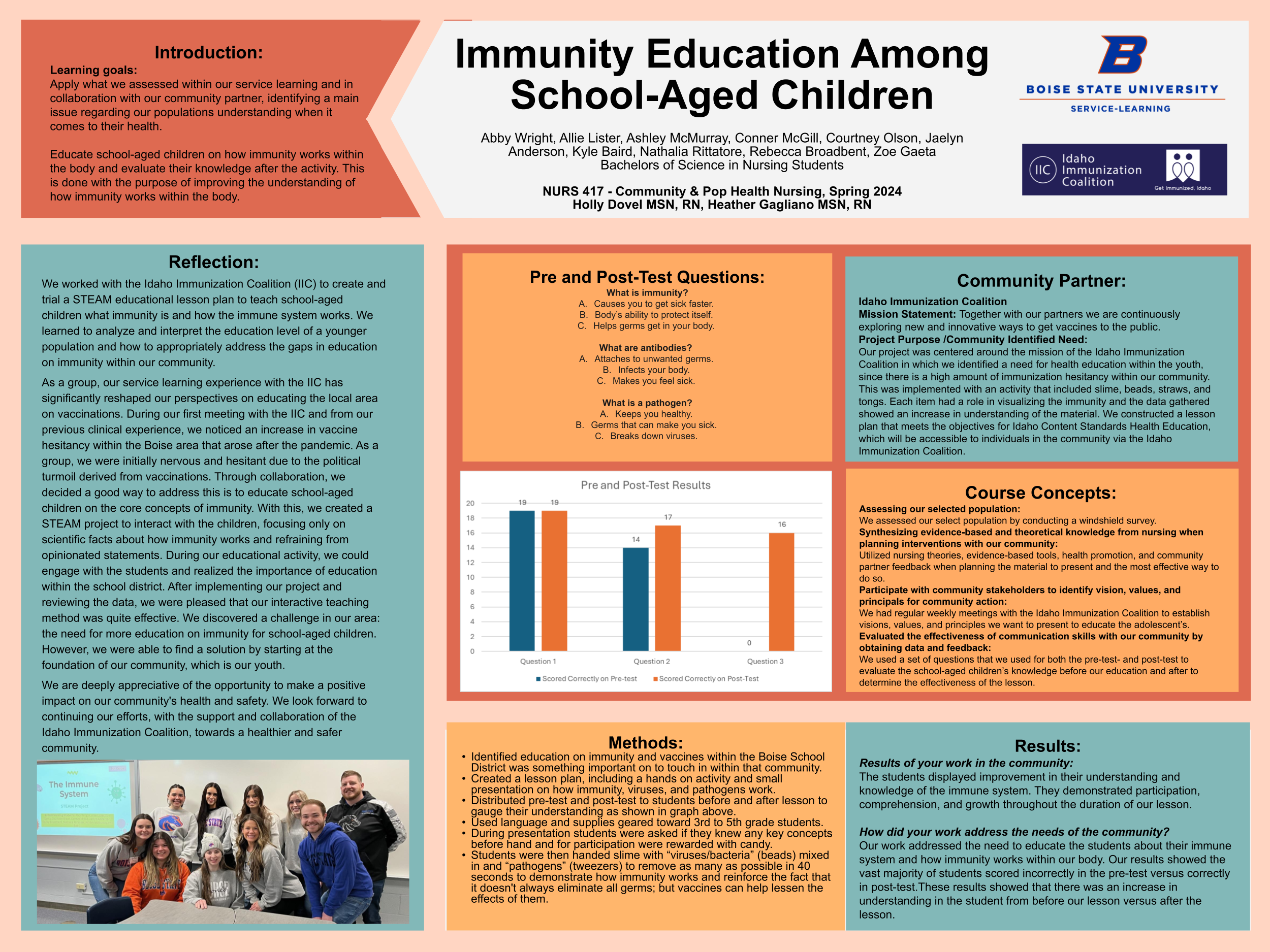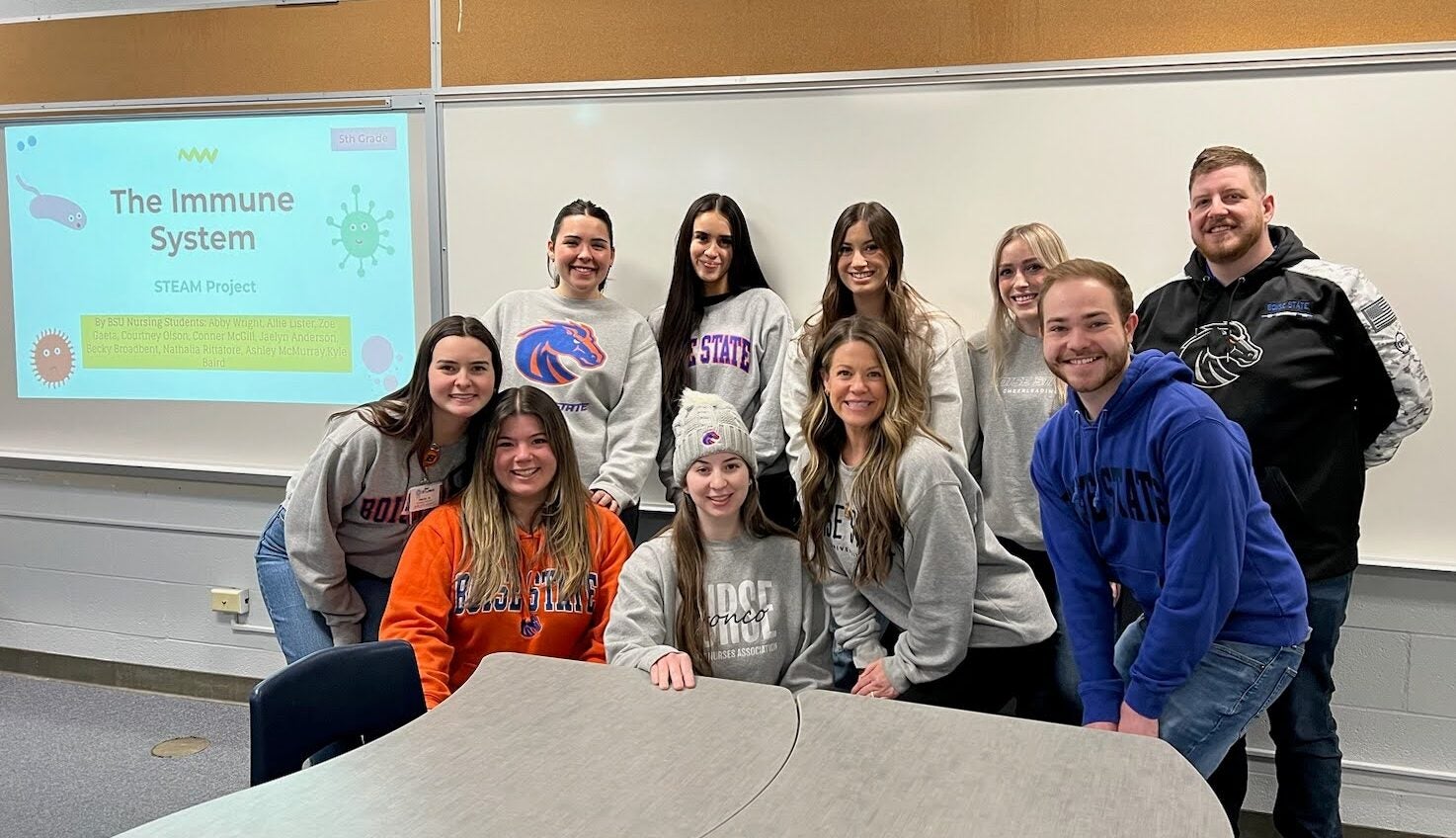Abby Wright, Allie Lister, Ashley McMurray, Conner McGill, Courtney Olson, Jaelyn Anderson, Kyle Baird, Nathalia Rittatore, Rebecca Broadbent, Zoe Gaeta
Holly Dovel MSN, RN, Heather Gagliano MSN, RN – NURS 417
Idaho Immunization Coalition

Introduction
Learning Goals:
Apply what we assessed within our service learning and in collaboration with our community partner, identifying a main issue regarding our populations understanding when it comes to their health.
Educate school-aged children on how immunity works within the body and evaluate their knowledge after the activity. This is done with the purpose of improving the understanding of how immunity works within the body.
Reflection
We worked with the Idaho Immunization Coalition (IIC) to create and trial a STEAM educational lesson plan to teach school-aged children what immunity is and how the immune system works. We learned to analyze and interpret the education level of a younger population and how to appropriately address the gaps in education on immunity within our community.

As a group, our service learning experience with the IIC has significantly reshaped our perspectives on educating the local area on vaccinations. During our first meeting with the IIC and from our previous clinical experience, we noticed an increase in vaccine hesitancy within the Boise area that arose after the pandemic. As a group, we were initially nervous and hesitant due to the political turmoil derived from vaccinations. Through collaboration, we decided a good way to address this is to educate school-aged children on the core concepts of immunity. With this, we created a STEAM project to interact with the children, focusing only on scientific facts about how immunity works and refraining from opinionated statements. During our educational activity, we could engage with the students and realized the importance of education within the school district. After implementing our project and reviewing the data, we were pleased that our interactive teaching method was quite effective. We discovered a challenge in our area: the need for more education on immunity for school-aged children. However, we were able to find a solution by starting at the foundation of our community, which is our youth.
We are deeply appreciative of the opportunity to make a positive impact on our community’s health and safety. We look forward to continuing our efforts, with the support and collaboration of the Idaho Immunization Coalition, towards a healthier and safer community.
Community Partner: Idaho Immunization Coalition

Mission Statement:
“Together with our partners we are continuously exploring new and innovative ways to get vaccines to the public.”
Project Purpose/Community Identified Need:
Our project was centered around the mission of the Idaho Immunization Coalition in which we identified a need for health education within the youth, since there is a high amount of immunization hesitancy within our community. This was implemented with an activity that included slime, beads, straws, and tongs. Each item had a role in visualizing the immunity and the data gathered showed an increase in understanding of the material. We constructed a lesson plan that meets the objectives for Idaho Content Standards Health Education, which will be accessible to individuals in the community via the Idaho Immunization Coalition.
Course Concepts
Assessing our selected population: We assessed our select population by conducting a windshield survey.
Synthesizing evidence-based and theoretical knowledge from nursing when planning interventions with our community: Utilized nursing theories, evidence-based tools, health promotion, and community partner feedback when planning the material to present and the most effective way to do so.
Participate with community stakeholders to identify vision, values, and principals for community action: We had regular weekly meetings with the Idaho Immunization Coalition to establish visions, values, and principles we want to present to educate the adolescent’s.
Evaluated the effectiveness of communication skills with our community by obtaining data and feedback: We used a set of questions that we used for both the pre-test- and post-test to evaluate the school-aged children’s knowledge before our education and after to determine the effectiveness of the lesson.
Methods
Identified education on immunity and vaccines within the Boise School District was something important on to touch in within that community.
Created a lesson plan, including a hands on activity and small presentation on how immunity, viruses, and pathogens work.
Distributed pre-test and post-test to students before and after lesson to gauge their understanding as shown in the previous graph.
Used language and supplies geared toward 3rd to 5th grade students.
During presentation students were asked if they knew any key concepts before hand and for participation were rewarded with candy. Students were then handed slime with “viruses/bacteria” (beads) mixed in and “pathogens” (tweezers) to remove as many as possible in 40 seconds to demonstrate how immunity works and reinforce the fact that it doesn’t always eliminate all germs; but vaccines can help lessen the effects of them.
Pre and Post-Test Results:

1.) What is immunity? Causes you to get sick faster.
Body’s ability to protect itself.
Helps germs get in your body.
2.) What are antibodies?
Attaches to unwanted germs.
Infects your body.
Makes you feel sick.
3.) What is a pathogen?
Keeps you healthy.
Germs that can make you sick.
Breaks down viruses.
Results
Results of your work in the community: The students displayed improvement in their understanding and knowledge of the immune system. They demonstrated participation, comprehension, and growth throughout the duration of our lesson.
How did your work address the needs of the community? Our work addressed the need to educate the students about their immune system and how immunity works within our body. Our results showed the vast majority of students scored incorrectly in the pre-test versus correctly in post-test. These results showed that there was an increase in understanding in the student from before our lesson versus after the lesson.